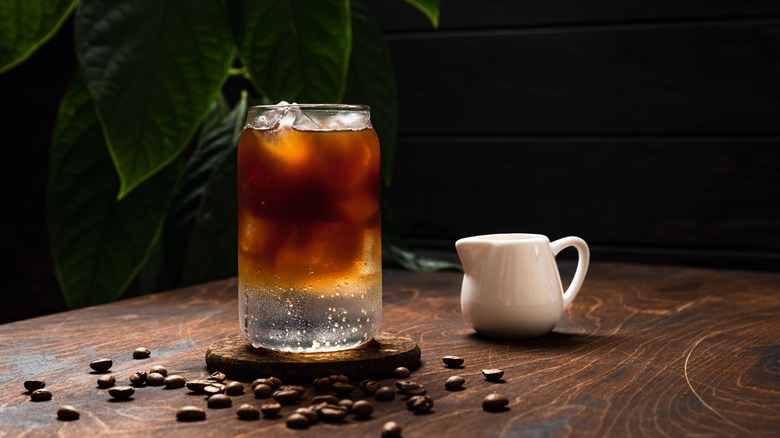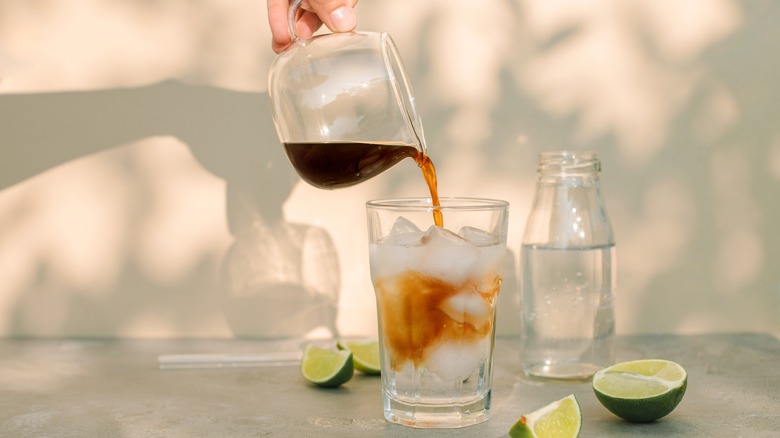The Type Of Coffee Roast To Avoid When Making An Espresso Tonic
It's easy to fall into habit with caffeine consumption — you make the same black coffee or the same cold brew every day as a matter of simplicity. But warmer weather tends to prompt refreshes of all kinds (cleaning out garages, shaking out linens, enlivening wardrobes), and it's the perfect opportunity to elevate your morning routine. Enter: The espresso tonic. This bright and bubbly drink likely first appeared in 2007, initially devised by a barista in Oslo then added to the menu of Koppi Roasters in Helsingborg, Sweden. Since the mixture was new and exciting, it was featured in barista competitions and eventually found its way to the U.S. around 2014, where it's stayed a darling of coffee connoisseurs ever since.
The concept is quite straightforward — in basic form, it's just a combination of espresso, tonic water, and ice. But the simplicity of the recipe does necessitate intention when choosing ingredients; since there are only three elements present, their individual tastes will stand out. So you have to be particularly careful when you pick your coffee beans, because not all roasts are created equal. When making an espresso tonic, you should stay away from darker roasts and their chocolatey flavor, opting instead for a roast that will pair with the citrus notes in tonic.
Ditch the dark roast, and favor fruit-forward
You'll find that dark, chocolate flavor in many standard espresso roasts, but the region will also matter. Brazil and other low-altitude growing areas in Latin America tend to produce coffee that is nutty, chocolatey, and less acidic; even higher altitudes like Colombia will produce caramel notes and only medium acidity. Roasts of this profile won't necessarily ruin your espresso tonic (and are quite delicious on their own), but they won't complement the bittersweet flavors of the tonic as well as others.
Tonic gets its bitterness from a compound called quinine, which is found in cinchona tree bark (and, interestingly, is a common treatment for malaria). The bitterness can be a little overwhelming, so most tonic waters have added sugar — which lends a sweetness and citrusy flavor to the drink. These tonic notes pair beautifully with roasts that are more fruit-forward, like those from Ethiopia. In growing regions all over that country, you'll find coffees with vibrant acidity and fruit flavors like blueberry, citrus, and wine. The exact tonic you should pick up will mostly be a matter of taste, but since these two ingredients make up two-thirds of the drink (and ice doesn't contribute a lot of flavor of its own), their compatibility is crucial.
Perfect espresso tonic every time
There are a few more factors to consider to ensure an exemplary espresso tonic. Firstly, avoid using room-temperature tonic — even though it's being poured over ice, an un-chilled tonic will start to melt the ice and water down the drink unnecessarily fast. The order of the pour also matters. Start by filling the glass with ice, then add the tonic water before you add the hot espresso. The other way around can sometimes cause the carbonation to overflow, and occasionally you'll get an unpleasant, clumpy foam. Aesthetically speaking, the order will also let you float the espresso on top of the tonic, creating an appealing differentiation of light and dark layers (but you might want to mix afterwards if you want a uniform taste).
Although espresso tonic is the original combination, you can opt for cold brew concentrate instead to save some time and make the drink even more refreshing. You can create your own cold brew coffee at home, but concentrate is typically a better choice than a mixed cold brew drink, because you don't want the espresso tonic to taste too diluted. And don't forget to check out the tasting notes on the bottle or coffee bean bag to make sure that you're getting fruit flavors instead of chocolate in your roast.


